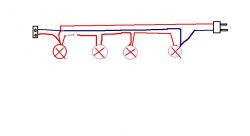Hello. I have 2 pairs of Christmas lights. Some are clipped into the other with a connector. The problem is that the second ones (attached to the first ones) glow whole. From the first part, only the first light and the last 5. Nothing shines between them. Tension comes to everyone. What may be the problem? I have no more ideas. I would like to add that after pulling them out of the cabinet and connecting them to the power socket, the voltage was present in both holes of the connector. Fortunately, I dealt with it and located the break at zero. Their connection looks like this: Three cables come out of the first bulb, two in the next. 3 cable from the first bulb runs to the last. Generally, 3 cables are only in the first and last bulb.



